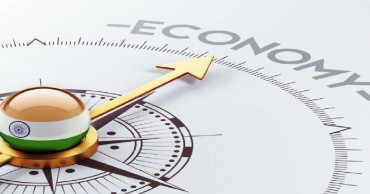Indian economy
India's digital economy to grow 10x to $800 bn by 2030
India’s consumer digital economy which was pegged at $85-90 billion in calendar year 2020, is expected to become a $800 billion market by 2030, according to reports released by consulting firm RedSeer at its flagship event Ground Zero 5.0.
The digital economy includes 60 per cent of travel, 40 per cent non-grocery retail, 30 per cent of education, 25 per cent of food and beverages services and 6 per cent of pharma/grocery going through digital channels by calendar year 2030.
Read: Indian economy, hit by COVID-19, shrinks by 7.3% in 2020-21
The Ground Zero 5.0 event was attended by Amitabh Kant, CEO of Niti Ayog along with TV Mohandas Pai, chairman, Manipal Global Education Services and Sanjeev Bikhchandani, co-founder, Info Edge along with other stalwarts of the startup industry.
“Over the last one decade, entrepreneurs have dedicated themselves to solve for the specific needs and pain areas of Indian consumers.
Read: Indian businesses urged to explore opportunities in Bangladesh
"Today, more than 50 per cent customers say they use online services because of convenience," said Anil Kumar, founder and CEO of RedSeer.
"Few years back almost over 70 per cent used to say the key reason is discounting but with the hit of Covid, digital services have undoubtedly served the customers very well, which is evident in high customer satisfaction and customers willingness to keep using the digital as a key channel to fulfill their needs.
"The next wave of entrepreneurs will create innovations which will make the Indian model successful globally."
According to the data released by RedSeer, 88 per cent of online shoppers that will be added between 2020-2030 will be from Tier-2, 3,4 cities.
Further, cumulatove incremntal online transactions are expected to be added worth $7 billion from tier-2-plus city customers over CY 20-30.
Overall, more than about $150 billion cumulative incremental online retail GMV is expected to be added from Tier-2-plus city customers over CY 20-30.
Additionally, kiranas are expected to achieve approximately achieve a $1.5 trillion sales by CY30.
The growth will be driven by platforms that are enabling these kiranas technologically and digitally, cashless payments, book keeping.
RedSeer further said that new-age logistics players created an opportunity of 500,000 employment for gig workers in 2020.
E-Logistics in India has become the fastest growing market globally with over 3 billion shipments in 2020, it said.
India traditionally had an inefficient supply chain with a slow and undemocratic access.
Today over 90 per cent of the orders fulfilled by the online commerce get done by the new age logistics, an industry which has come up only in the last one decade and has solved for the above challenges through technology and customer centric mindset.
Further, three out of the top 10 logistics players in India are today the new age (e- logistics) players.
The new age logistics players are expected to deliver 2.5 billion D2C shipments by 2030.
With the rise of e-commerce, the need for specialized delivery service emerged, which led to the overall growth of the logistics segment.
Emergence of this sector created 500,000 employment for gig workers in 2021.
New age logistics players have reduced the average time of delivery by 2/3rd in last seven years, have covered nearly all the pin codes across India through enabled deep tech solutions to serve the different type of customer needs and requirements like same day delivery, hyperlocal, service enabled etc.
Other sectors in the new-age economy have also been strongly impacted by the pandemic.
A number of new trends are emerging in these various sectors which will shape the ecosystem going forward.
According to RedSeer research, shared mobility saw a sharp decline due to the second Covid wave-led lockdowns in the last two months.
Although the autos segment recovered the fastest, the overall sector merely clocked 18 million rides, a drop from 113 million rides in January last year.
However, while the shared mobility is dipping, personal mobility space is riding on a wave of strong traction seen since last year.
While auto OEMs have responded with relevant offerings to democratize access to cars, tech platforms are also accelerating focus on digitizing the car ownership journey.
Online used car transaction penetration is expected to grow almost nine times in the next nearly 10 years.
Another category that is ripe for digital disruption is the car service and repairs market which is still a highly fragmented market which faces challenges like inefficiencies, bloated pricing and poor experience for both consumers and service workshops.
This segment is expected to penetrate about 15 per cent of this highly fragmented market by CY30.
This article was first published in Rediff.com
4 years ago
Indian economy, hit by COVID-19, shrinks by 7.3% in 2020-21
India’s economy, pummeled by the coronavirus pandemic, contracted by 7.3% in the 2020-21 financial year, just before the country was hit by another catastrophic surge in infections.
The economy grew at a 1.6% annual rate in the January-March quarter, according to figures released Monday by the government, but that recovery was stifled by a resurgence of infections in March. Daily new cases set global records, spurring many states to announce widespread restrictions and lockdowns.
New cases and deaths recently have begun to decline, but much of the country is still under some form of a shutdown, with many industries and businesses unable to resume work.
In January, a government survey estimated the economy -- previously one of the fastest growing among major nations -– would bounce back, expanding 11% in the current fiscal year, which began in April. But some ratings agencies say growth is likely to slow to about 10% due to the most recent surge in COVID-19 cases.
Read: COVID-19 might leave adverse impact on Indian economy
On Monday, India registered over 150,000 new cases and more than 3,000 deaths. Overall, the country has the second highest total number of infections, after the United States, with more than 28 million confirmed cases and nearly 330,000 deaths. Both figures are believed to be vast undercounts.
After registering a daily peak of over 400,000 new cases in May, experts say infections seem to be easing, especially in the capital, New Delhi, and Mumbai. But there is concern the virus may still be rampant in the poorer countryside, where access to health care is more limited.
Even though many states and cities remain under lockdown, a few have started to ease curbs on some types of economic activity. New Delhi Chief Minister Arvind Kejriwal has extended the current lockdown to June 7, but announced that manufacturing and construction activities can resume from Monday with health measures in place.
“We have to maintain a balance between controlling the spread of COVID-19 and allowing economic activities,” Kejriwal said at a virtual news briefing on Friday, according to the Press Trust of India news agency.
Kejriwal said the lockdown will be gradually lifted, with an emphasis on helping the most vulnerable, such as day laborers and migrant workers, many of whom work in factories and construction sites. Many such workers were left unemployed overnight when the government imposed a sudden lockdown in March last year, causing huge distress.
India’s economy grew at a 0.4% annual pace in the October-December quarter, after two consecutive contractions pushed the country into a recession last year.
4 years ago
Coronavirus: India reports 96,000 cases
India saw another spike as the health authorities announced 96,551 cases in the past 24 hours on Friday as it ordered retesting of many people whose first results were from the less reliable rapid antigen tests being widely used.
5 years ago
2019, a year of slowdown for Indian economy
India has seen a economic slowdown in 2019, with the country's real estate, automobile, construction sectors and overall consumption demand facing a serious and constant decline.
5 years ago





